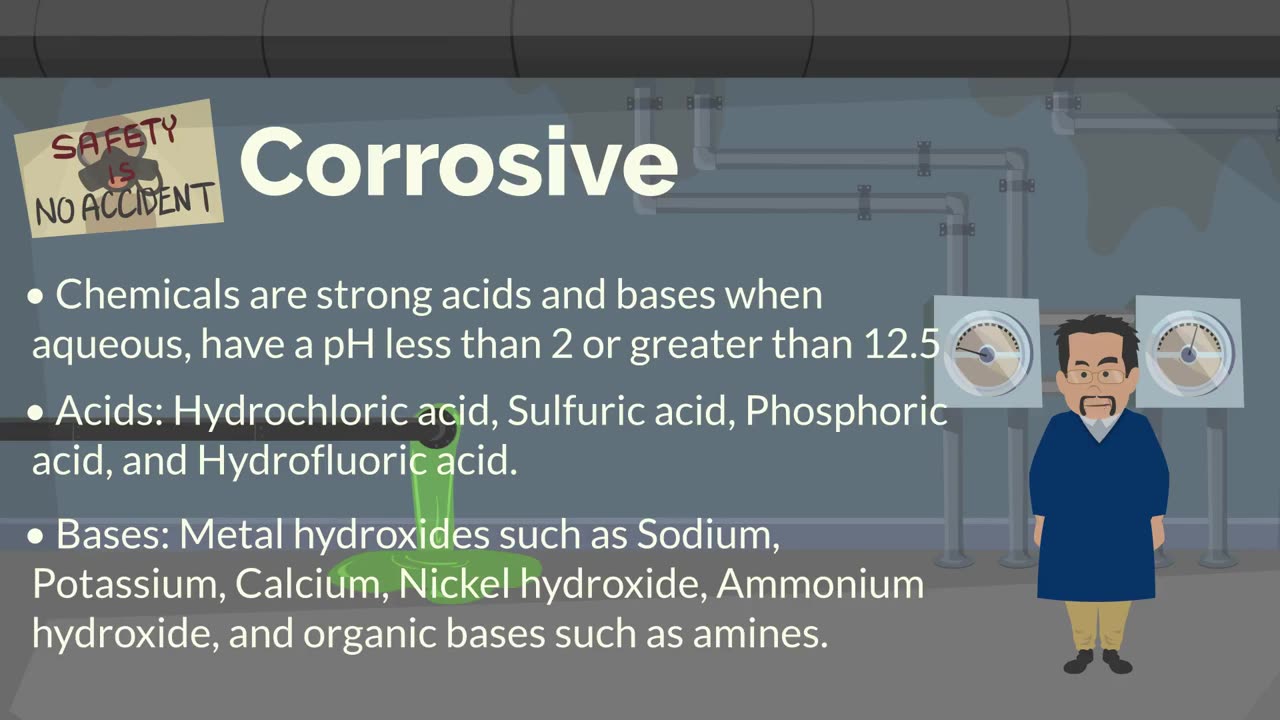Premium Only Content

Chemical Hazard Recognition_ TRIC
**Chemical Hazard Recognition: TRIC**
The acronym **TRIC** can be used as a systematic approach to recognize and address chemical hazards. It stands for **Toxicity, Reactivity, Ignitability, and Corrosivity**. Here's how each component helps in chemical hazard recognition:
---
### **1. Toxicity**
- **Definition**: The potential of a chemical to cause harm to living organisms through inhalation, ingestion, or skin contact.
- **Indicators**:
- Pictograms or labels indicating "Toxic," "Harmful," or "Dangerous."
- Consult the Safety Data Sheet (SDS) for information on lethal doses (LD50) and permissible exposure limits (PEL).
- **Recognition**:
- Examples: Carbon monoxide, cyanide, and pesticides.
- Observe symptoms like dizziness, nausea, or irritation.
---
### **2. Reactivity**
- **Definition**: The chemical's tendency to react violently or release energy when exposed to certain conditions (e.g., heat, water, or other chemicals).
- **Indicators**:
- Terms like "Unstable," "Explosive," or "Reactive" on labels.
- SDS section on stability and reactivity.
- **Recognition**:
- Examples: Sodium reacts with water; peroxides are shock-sensitive.
- Look for storage warnings like "Keep away from heat or incompatible substances."
---
### **3. Ignitability**
- **Definition**: The ability of a chemical to catch fire under certain conditions.
- **Indicators**:
- Flashpoint data on the SDS.
- Flammable or combustible warnings.
- Pictograms like the flame symbol.
- **Recognition**:
- Examples: Gasoline, ethanol, and acetone.
- Check for proper grounding and storage in fire-safe cabinets.
---
### **4. Corrosivity**
- **Definition**: The ability of a chemical to destroy or irreversibly damage materials, including skin and metals.
- **Indicators**:
- Pictograms or warnings indicating "Corrosive."
- SDS sections on handling precautions.
- **Recognition**:
- Examples: Sulfuric acid, sodium hydroxide, and hydrochloric acid.
- Observe physical signs of damage to containers or PPE.
---
### **Application of TRIC in Safety**
1. **Assessment**: Use TRIC to evaluate the potential risks of chemicals during storage, transportation, and usage.
2. **Training**: Educate employees about recognizing hazards and understanding labels and SDS.
3. **Controls**: Implement engineering controls (e.g., fume hoods), administrative controls (e.g., safe work practices), and PPE to mitigate risks.
Would you like this concept expanded into a training presentation or animation script?
-
 20:24
20:24
HSESafetyInformation
7 months agoKABULI PULAO RECIPE - Original 40+ KG Afghani Meat Pulau Prepared - Street Food Qabili Plav Recipe_2
35 -
 1:06:26
1:06:26
vivafrei
4 hours agoLive with Alexa Lavoie! ANTIFA in Canadian Government? RCMP the New Gestapo? AND MORE!
143K44 -
 40:38
40:38
Dad Saves America
1 day ago $1.10 earnedLeft Is Right, Up Is Down: The Overton Window Has Been Shattered
19.3K3 -
 LIVE
LIVE
LFA TV
19 hours agoBREAKING NEWS ALL DAY! | TUESDAY 9/30/25
814 watching -
 1:41:28
1:41:28
freecastle
7 hours agoTAKE UP YOUR CROSS- May the forces of evil become confused on the way to your house.
18.7K4 -
 1:23:05
1:23:05
Awaken With JP
6 hours agoGetting NUTS! FBI Did J6, Comey Indicted, and More! - LIES ep 110
67.6K34 -
 2:09:51
2:09:51
Pop Culture Crisis
4 hours agoJK Rowling OBLITERATES Emma Watson, Trump Vs Ariana Grande, Could The Rock be President? | Ep. 926
51.3K13 -
 1:46:23
1:46:23
The HotSeat
3 hours agoCommander In Chief and SECWAR Address The Troops, and I AM HERE FOR IT!
28.2K16 -
![[Ep 759] Resist Digital ID | Dems to Shut Down Gov | Obama Library Funds Tides / Terrorists](https://1a-1791.com/video/fwe2/55/s8/1/8/U/L/m/8ULmz.0kob-small-Ep-759-Resist-Digital-ID-De.jpg) 2:11:49
2:11:49
The Nunn Report - w/ Dan Nunn
3 hours ago[Ep 759] Resist Digital ID | Dems to Shut Down Gov | Obama Library Funds Tides / Terrorists
20.1K7 -
 1:42:33
1:42:33
The Quartering
7 hours agoFat Soldiers BLASTED, Kirk Assassin In Court, JK Rowling Destroys Emma Watson & Crowder Takes Risk
138K29